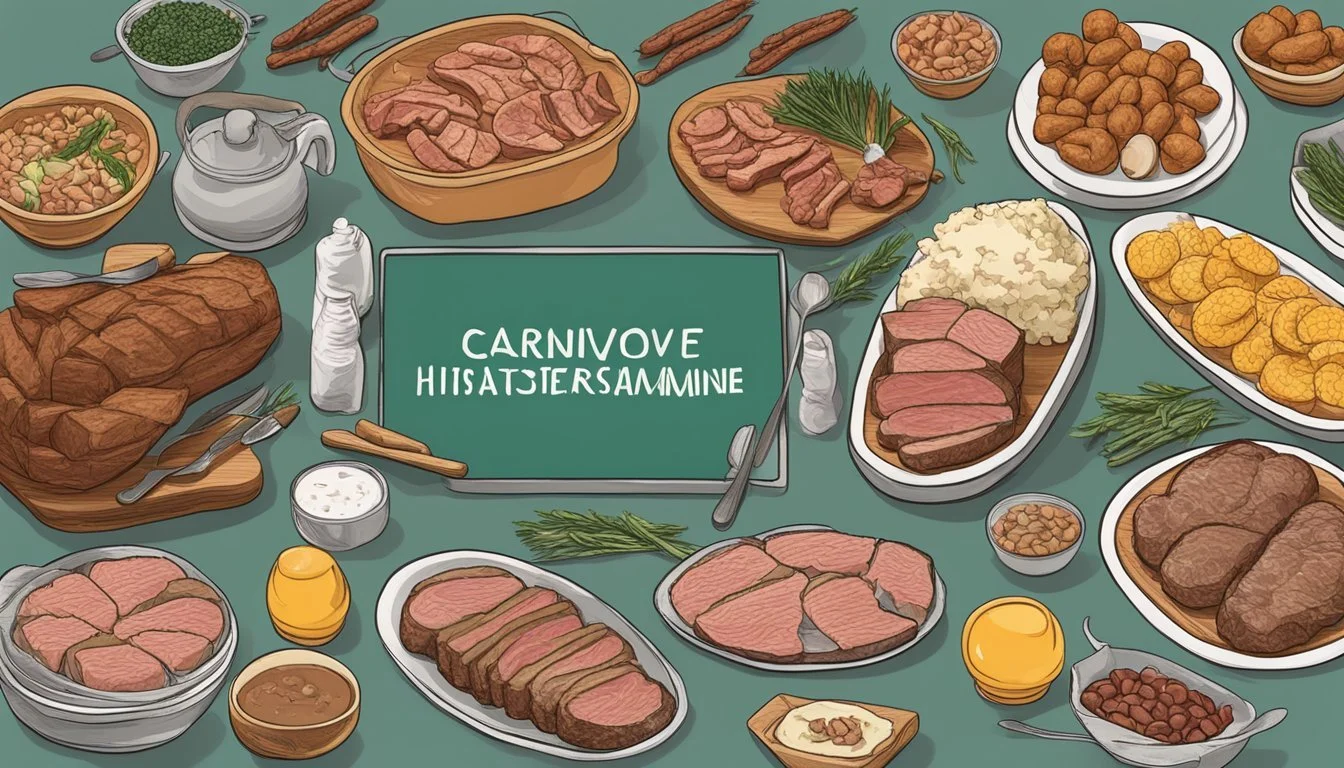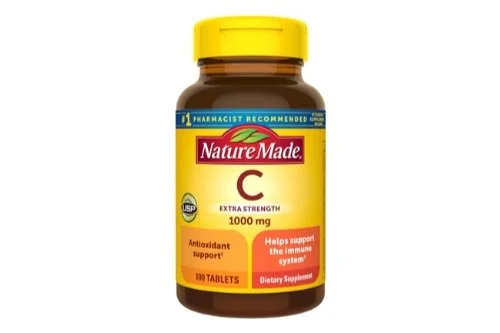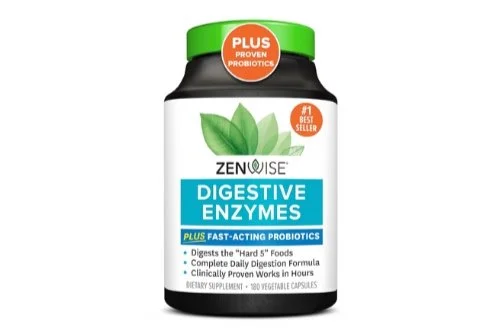Carnivore Diet and Addressing Histamine Intolerance
A Strategic Approach
Histamine intolerance occurs when there's an imbalance between the buildup of histamine and the body's ability to break it down. Histamine is a chemical involved in the immune system, digestion, and central nervous system regulation. It's also found in many foods, particularly those that are aged or fermented. Symptoms of histamine intolerance can include hives, digestive upset, and headaches. The carnivore diet, which consists solely of animal products, eliminates many high-histamine foods and has been adopted by some as a means to manage symptoms.
Although the carnivore diet reduces the intake of many high-histamine foods, it's important to consider that certain animal products, especially those that are processed or not fresh, can also be high in histamine. For those dealing with histamine intolerance, meat freshness, and the methods of food processing and preparation can be critical to managing symptoms. The philosophy behind the carnivore approach for addressing histamine intolerance relies on a strict elimination protocol, targeting the removal of potential histamine triggers found in plant-based foods.
Researchers and individuals on the diet have reported improvements in digestive issues, a reduction in brain fog, and a general alleviation of immune-related symptoms when adhering to a carnivore diet with consideration for histamine levels. The anecdotal evidence suggests that the diet might work for some by simplifying dietary choices and possibly reducing the overall histamine burden. Nevertheless, the approach lacks extensive scientific research, and individuals considering this diet should consult with health professionals, particularly to ensure nutritional adequacy and to tailor the diet to their specific needs.
Understanding Histamine
Histamine plays a pivotal role in allergic responses and inflammatory processes, yet its excessive presence in the body can lead to intolerance, producing an array of discomforting symptoms.
Basics of Histamine and Histamine Intolerance
Histamine is a biogenic amine involved in local immune responses, acting as a neurotransmitter and a regulator of stomach acid production. Histamine intolerance (HIT) occurs when the histamine level exceeds the body’s capacity to break it down, primarily because of impaired enzymatic activity. An overload of histamine can lead to symptoms like sneezing, itching, hives, and digestive issues.
Key Points:
Histamine: An amine that regulates physiological functions and mediates allergic reactions.
Symptoms of HIT: Include sneezing, itching, and digestive discomfort.
Histamine Overload: Results when histamine degradation is outpaced by its accumulation.
Role of Diamine Oxidase (DAO) in Histamine Management
Diamine oxidase (DAO) is the main enzyme for metabolizing and inactivating ingested histamine. When DAO is deficient or its activity is compromised, it can result in an increase in systemic histamine concentrations, triggering symptoms associated with histamine intolerance. The efficiency of DAO can be influenced by genetic factors, medications, and gastrointestinal diseases.
Essential Facts:
Diamine Oxidase (DAO): The primary enzyme for breaking down histamine.
DAO Deficit: Leads to heightened histamine levels and intolerance symptoms.
Influencing Factors: Genetics, drugs, and gut health can affect DAO levels.
Allergic Reactions and Atopic Dermatitis
Histamine's excessive release in the body is a common cause of allergic reactions, which can manifest as atopic dermatitis or more generalized systemic reactions. Atopic dermatitis, a type of eczema, is characterized by inflamed, itchy, and red skin. Increased histamine levels can exacerbate these conditions, leading to an intense itch-scratch cycle and discomfort.
Considerations:
Allergic Reaction: A result of histamine binding to its receptors on certain cells.
Atopic Dermatitis: Can be worsened by excess histamine, resulting in more severe itching and inflammation.
Histamine's Role: Central to the development of symptoms in both localized and systemic allergic responses.
The Carnivore Diet
The Carnivore Diet focuses on consuming primarily animal products and excludes plant-based foods, positioning itself as a potentially effective approach for individuals with specific dietary sensitivities or autoimmune disorders.
Principles of the Carnivore Diet
The Carnivore Diet is centered on the idea that human beings may thrive on animal-based nutrition. This restrictive diet is characterized by a high intake of meats and animal products while completely eliminating plant-based foods. Proponents believe that this diet may contribute to improved gut health and a reduced immune response associated with food sensitivities.
Protein Focus and Low Carbohydrate Intake
Protein is the cornerstone of the Carnivore Diet, with a strong emphasis on meat, fish, eggs, and dairy, if tolerated. Carbohydrates are minimized to near zero, as this diet excludes traditional carb sources like fruits, vegetables, grains, and legumes, which may help in regulating blood sugar levels and supporting weight management.
Avoiding Plant-Based Foods and Potential Allergens
Individuals on the Carnivore Diet avoid all plant-based foods, which can contain compounds like oxalates or phytic acid that some believe may irritate the gut lining. By doing so, the diet aims to reduce exposure to potential allergens and anti-nutrients, potentially benefiting those with autoimmune disorders or histamine intolerance.
Combating Histamine Intolerance
Individuals with histamine intolerance can benefit from strategic dietary adjustments focusing on food selection, preparation, and supporting gut health to help manage symptoms.
Low Histamine Diet Strategies
Adopting a low histamine diet is a critical step in managing histamine intolerance. This approach involves:
Avoiding foods known to be high in histamine, such as aged cheeses (What wine goes well with aged cheeses?), processed meats, and alcoholic beverages.
Choosing low-histamine foods like fresh meat, non-citrus fruits, and eggs.
Recommended Food Choices by Type
Meats:
Recommended Choices: Freshly cooked meats
Fruits:
Recommended Choices: Apples, pears
Vegetables:
Recommended Choices: Carrots, squash
Grains:
Recommended Choices: Rice, oats
Dairy Substitutes:
Recommended Choices: Coconut milk, almond milk
Importance of Food Freshness
Freshness greatly influences the histamine content in foods, as histamine levels increase over time. For those on a carnivore diet, this particularly means:
Purchasing fresh meat and eating it promptly.
Storing perishables at proper temperatures immediately after procurement.
Adjusting Cooking Methods
Certain cooking methods may impact histamine levels in food. It's beneficial to:
Favor fast cooking techniques like grilling or pan-searing to minimize histamine formation.
Avoid slow-cooking methods which may lead to increased histamine due to prolonged cooking times.
Experience the convenience and savings of buying an electric grill and frying pan online!
Inclusion of Probiotics and Gut Health
A healthy microbiome can play a role in histamine management by degrading histamine through the action of specific bacteria. Incorporating probiotic foods such as:
Yogurt or kefir (for those who are not strictly carnivore).
Probiotic supplements are designed to bolster gut health and reduce inflammation associated with histamine intolerance.
Online stores offer unbeatable prices for probiotic supplements, so don't miss out!
Specific Food Considerations
In addressing histamine intolerance, it is crucial to identify specific foods that are safe to consume and those that might exacerbate symptoms. This section will explore suitable protein sources, the role of vegetables, and problematic foods that should typically be avoided.
Safest Types of Protein: Fish and Eggs
When following a carnivore diet, fresh fish and eggs are generally considered safer protein choices for those with histamine intolerance. Fish should be freshly caught and cooked as histamine levels can increase with improper handling and storage. Types of fresh fish useful for a low-histamine diet include:
Salmon
Trout
Arctic char
Eggs are typically well-tolerated and do not contain histamine, making them a valuable protein source for this dietary approach.
Role of Vegetables in a Low Histamine Diet
Although the carnivore diet typically excludes plant-based foods, individuals with histamine intolerance who include vegetables might consider those with anti-inflammatory properties and low histamine levels. Vegetables such as:
Leafy greens (spinach, kale)
Squash
Zucchini
Bell peppers
Note: Fermented vegetables like sauerkraut, usually rich in probiotics, can be high in histamine and are better to avoid.
Problematic Foods to Avoid
Certain foods are known for their high histamine levels or their potential to release or impair histamine breakdown, and people with histamine intolerance are advised to avoid these. They include:
Aged cheeses: These can be high in histamine due to the fermentation process.
Processed meats: Histamine levels can increase due to bacterial activity during processing.
Fermented products: Foods like yogurt and kefir can be problematic.
Alcoholic beverages: Especially wine and beer, are known to be high in histamine and can also block histamine breakdown.
Milk, while not high in histamine itself, might cause issues for some individuals, therefore, alternatives or moderation may be considered.
Managing Symptoms
When addressing histamine intolerance on a carnivore diet, it's essential to consider supplementation, dietary tweaks, and the potential need to address gut health issues such as SIBO and chronic inflammation, which can exacerbate symptoms like brain fog.
Supplements and Medications
Individuals may benefit from supplements such as Vitamin C and quercetin, which can help mitigate histamine's effects. Some find relief using over-the-counter antihistamines, but these should be used under the guidance of a healthcare professional. DAO enzyme supplements can also aid in breaking down dietary histamine.
Vitamin C – can help degrade histamine and has immune-supporting properties.
Quercetin – has natural antihistamine effects that stabilize mast cells to reduce histamine release.
DAO enzyme – assists in histamine breakdown if naturally occurring DAO is insufficient.
Discover the endless possibilities of buying Vitamin C, Quercetin, and DAO enzymes online!
Dietary Adjustments
A tailored meal plan that avoids high-histamine foods and includes proper seasoning choices suitable for histamine intolerance can be pivotal.
Avoid Foods High in Histamine: Such as aged meats and certain dairy products.
Choose Fresh Meat: Freshly cooked or flash-frozen meats have lower histamine levels.
Mindful Seasoning: Opt for fresh herbs and salt, avoiding spices that may trigger histamine release.
Identifying and Treating SIBO and Chronic Inflammation
Small Intestinal Bacterial Overgrowth (SIBO) and chronic inflammation can contribute significantly to histamine intolerance. A healthcare professional can diagnose and suggest treatment, which may include:
Antibiotics or Herbal Antimicrobials: To address bacterial overgrowth in SIBO.
Probiotics and Prebiotics: To rebalance gut flora and reduce chronic inflammation.
Low-FODMAP Diet: Temporarily reducing intake of certain carbohydrates can alleviate symptoms.
Engaging with a healthcare provider can help manage these conditions, potentially reducing histamine-related symptoms and improving overall well-being.
Lifestyle and Dietary Support
When embarking on a carnivore diet to address histamine intolerance, lifestyle adjustments and proper dietary strategies are essential for managing gastrointestinal symptoms effectively. Consulting a registered dietitian, crafting a sustainable meal plan, and learning to cope with a restrictive diet are key steps for success.
Consulting a Registered Dietitian
A registered dietitian who understands histamine intolerance can be a valuable resource. They provide evidence-based advice, ensuring one's diet optimally supports gastrointestinal health while mitigating histamine-related symptoms. This professional guidance can help individuals adhere to the carnivore diet without compromising nutritional adequacy.
Creating a Sustainable Meal Plan
Developing a meal plan geared towards low-histamine foods is critical for maintaining this diet long-term. A meal plan should include:
Fresh, high-quality animal products (e.g., grass-fed beef, pasture-raised chicken)
Wild-caught fish known to be lower in histamine
A rotation scheme to prevent boredom and ensure a variety of nutrients
This approach prevents the consumption of high-histamine foods like aged meats and fermented foods (What wine goes well with fermented foods?) while promoting dietary adherence.
Coping with Restrictive Diets
Managing a restrictive diet requires psychological resilience and practical coping strategies. Individuals may:
Find and create support groups for those with histamine intolerance
Identify convenient, histamine-friendly food options for simplicity and variety
Educate friends and family about their dietary needs to facilitate social gatherings
These coping mechanisms support individuals in maintaining their diet and lifestyle changes over time.
Further Information on Histamine-Rich Foods
This section provides an in-depth look at biogenic amines in various foods and lists those high in histamines, which are crucial for individuals with histamine intolerance to identify and manage their condition.
Exploring Biogenic Amines in Foods
Biogenic amines are organic compounds that occur naturally in various foods and play roles in physiological functions. They form through the decarboxylation of amino acids or by the amination and transamination of aldehydes and ketones during the storage and fermentation of foods. Histamine, one of the most prominent biogenic amines, can cause adverse reactions in histamine-intolerant individuals, especially when enzymes like diamine oxidase (DAO) are deficient and unable to effectively degrade histamine in the digestive system.
List of Foods with High Levels of Histamine
Certain foods are known for their high histamine content and should be considered by those with histamine intolerance:
Fruits: Despite being healthy, some fruits like strawberries, kiwi, and pineapples have higher levels of histamine. Plums and citrus fruits, while containing moderate to low histamine levels, may still trigger symptoms in sensitive individuals.
Vegetables: Many beans and soybeans contain histamine or histamine liberators, which can contribute to symptoms.
Nuts: Various nuts are listed among histamine-rich foods and can exacerbate symptoms in those with intolerance.
Protein Sources: Aged meats, such as cured sausages and dried meats, are typically high in histamines due to the fermentation and aging process they undergo.
Dairy Products: Cheese, particularly aged varieties, tend to have significant histamine levels.
For those managing histamine intolerance, being aware of these foods is the first step towards adjusting their diet and reducing the occurrence of adverse reactions. It's important to consult with a healthcare professional for personalized advice and management strategies.








